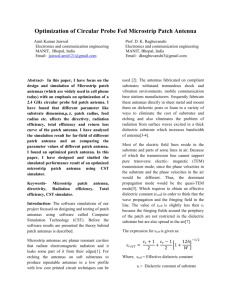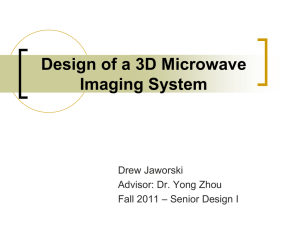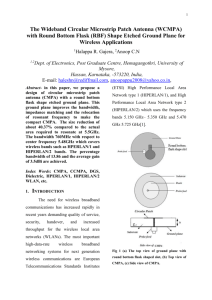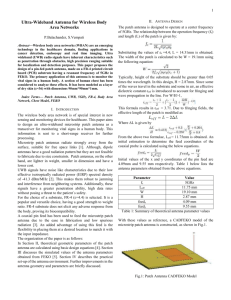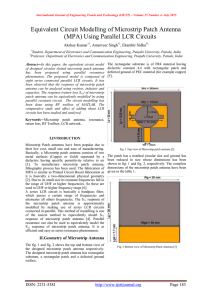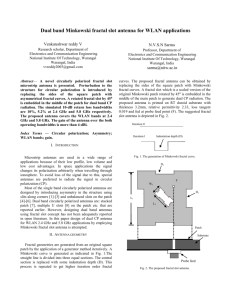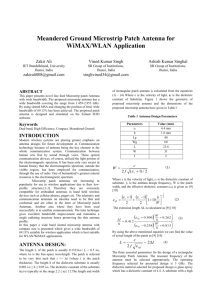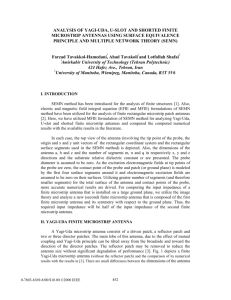DIAMOND SHAPE MICROSTRIP ANTENNA USING “SLOTS”
advertisement
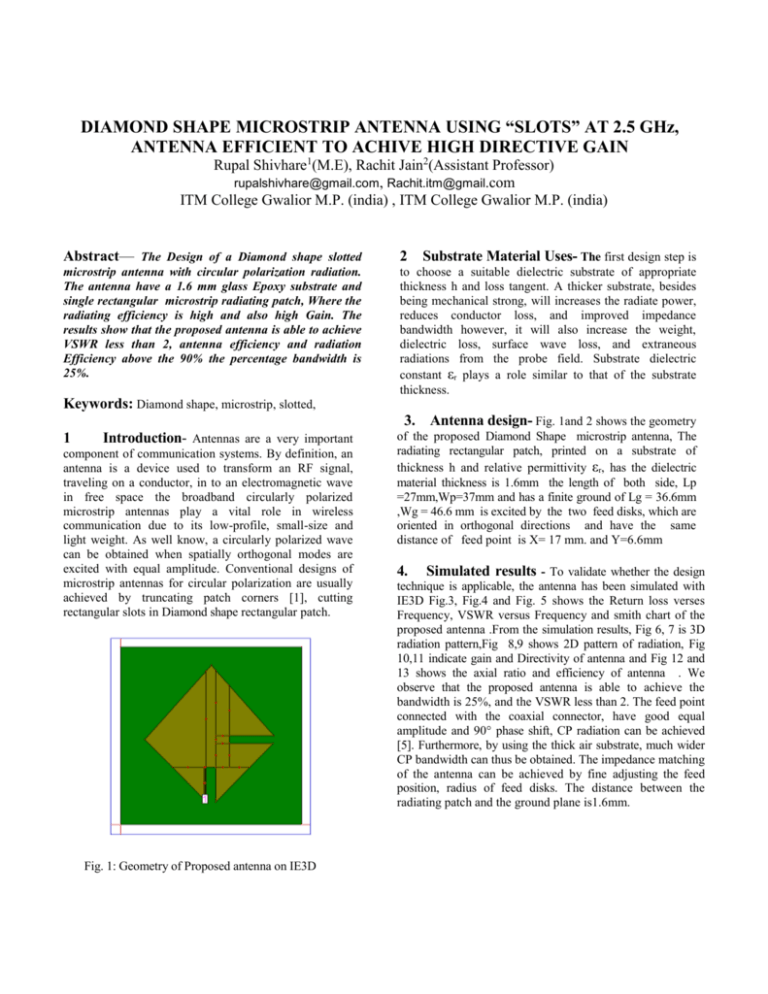
DIAMOND SHAPE MICROSTRIP ANTENNA USING “SLOTS” AT 2.5 GHz, ANTENNA EFFICIENT TO ACHIVE HIGH DIRECTIVE GAIN Rupal Shivhare1(M.E), Rachit Jain2(Assistant Professor) rupalshivhare@gmail.com, Rachit.itm@gmail.com ITM College Gwalior M.P. (india) , ITM College Gwalior M.P. (india) Abstract— The Design of a Diamond shape slotted microstrip antenna with circular polarization radiation. The antenna have a 1.6 mm glass Epoxy substrate and single rectangular microstrip radiating patch, Where the radiating efficiency is high and also high Gain. The results show that the proposed antenna is able to achieve VSWR less than 2, antenna efficiency and radiation Efficiency above the 90% the percentage bandwidth is 25%. 2 Substrate Material Uses- The first design step is to choose a suitable dielectric substrate of appropriate thickness h and loss tangent. A thicker substrate, besides being mechanical strong, will increases the radiate power, reduces conductor loss, and improved impedance bandwidth however, it will also increase the weight, dielectric loss, surface wave loss, and extraneous radiations from the probe field. Substrate dielectric constant εr plays a role similar to that of the substrate thickness. Keywords: Diamond shape, microstrip, slotted, 1 Introduction- Antennas are a very important component of communication systems. By definition, an antenna is a device used to transform an RF signal, traveling on a conductor, in to an electromagnetic wave in free space the broadband circularly polarized microstrip antennas play a vital role in wireless communication due to its low-profile, small-size and light weight. As well know, a circularly polarized wave can be obtained when spatially orthogonal modes are excited with equal amplitude. Conventional designs of microstrip antennas for circular polarization are usually achieved by truncating patch corners [1], cutting rectangular slots in Diamond shape rectangular patch. Fig. 1: Geometry of Proposed antenna on IE3D 3. Antenna design- Fig. 1and 2 shows the geometry of the proposed Diamond Shape microstrip antenna, The radiating rectangular patch, printed on a substrate of thickness h and relative permittivity εr, has the dielectric material thickness is 1.6mm the length of both side, Lp =27mm,Wp=37mm and has a finite ground of Lg = 36.6mm ,Wg = 46.6 mm is excited by the two feed disks, which are oriented in orthogonal directions and have the same distance of feed point is X= 17 mm. and Y=6.6mm 4. Simulated results - To validate whether the design technique is applicable, the antenna has been simulated with IE3D Fig.3, Fig.4 and Fig. 5 shows the Return loss verses Frequency, VSWR versus Frequency and smith chart of the proposed antenna .From the simulation results, Fig 6, 7 is 3D radiation pattern,Fig 8,9 shows 2D pattern of radiation, Fig 10,11 indicate gain and Directivity of antenna and Fig 12 and 13 shows the axial ratio and efficiency of antenna . We observe that the proposed antenna is able to achieve the bandwidth is 25%, and the VSWR less than 2. The feed point connected with the coaxial connector, have good equal amplitude and 90° phase shift, CP radiation can be achieved [5]. Furthermore, by using the thick air substrate, much wider CP bandwidth can thus be obtained. The impedance matching of the antenna can be achieved by fine adjusting the feed position, radius of feed disks. The distance between the radiating patch and the ground plane is1.6mm. . Fig. 5: Smith chart of S parameter Fig. 2: 3D view of Geometry Fig. 3: Return loss Vs frequency. Fig. 4 : VSWR versus frequency Fig.6: 3D Radiation pattern view Fig.7: Side view of 3D Radiation pattern view Fig.11: Directivity Vs frequency Fig.8: 2D Radiation pattern view of gain Fig.9: 2D Radiation pattern view of Directivity Fig.12: Axial ratio Vs frequency Fig.13: Efficiency Vs frequency Fig.10: Gain Vs frequency Table.1 content the antenna parameter Fo ( operating frequency) 2.5 GHz h (height of dielectric) 1.6 mm εr (dielectric constant) 4.4 mm Lp (length of patch) 27 mm Wp (width of patch) 37 mm Lg (length of patch) 36.6 mm Wg (width of patch) 46.6 mm Fr (resonant frequency) 2.5 GHz Table.1 Table.2 content IE3D output Frequency in GHz. 2.5 Resonant Frequency GHz 2.5 IE3D output (return loss ) -21.25db Table.2 In this paper, a new design of Diamond shape microstrip antenna with 2.5 GHz. The antenna have an output by using IE3D antenna resonant at the frequency of 2.5and have greater return loss of -21.25 db. A thick air substrate is used in the present proposed design, and impedance matching is obtained through the rectangular radiating patch. The results show that the proposed antenna is able to achieve VSWR less than 2 and the return loss is less then -10.db. 4. Conclusions- Characteristics of rectangular Diamond Shape microstrip antenna have been analysis, The proposed antenna is achieved gain of 4 db, efficiency is more than 90% and band limit is lies between the WLAN region, microstrip antenna is able to achieve VSWR less than 2 and the return loss is less the -10db and in this paper the bandwidth is 25% . References [1] Z. L. Dafalla, W. T. Y. Kuan, A. M. Abdel Rahman, and S. C. Shudakar, “Design of a Rectangular Microstrip Patch Antenna at 1 GHz”, Rf And Microwave Conference, October 5 - 6- 2004, Subang, Selangor, Malaysia [2] C.Y. Chiu, C.H. Chan and K.M. Luke, “Study of slotted microstrip patch antennas with folded patch feed ”, Microwave Antennas propagation., vol. 152, no. 5, October 2005 [3] C -Y Huang, J-Y Wu and K-L Wong , “Cross-slot-coupled microstrip antenna and dielectric resonator antenna for circular polarization”,. IEEE Trans on Antennas and Propagate, 1999, PP-47 [4] S Matsuzawa and K Ito. Circularly polarized printed antenna fed by coplanar waveguide. Electronic. Letter, Vol.32 No.22, 1996 [5] S. D. Targonski and D. M. Pozar. Design of wide- band circularly polarized aperture coupled microstrip antenna. IEEE Trans. on Antennas and Propagate, vol. 41, pp. 214-220, 1993.
